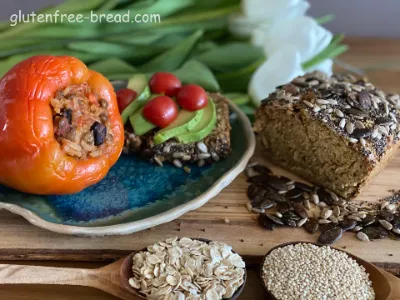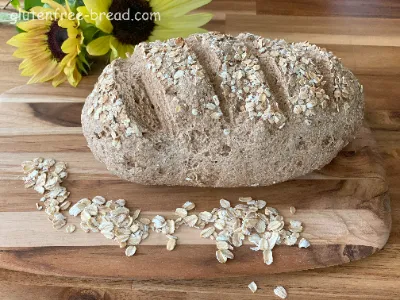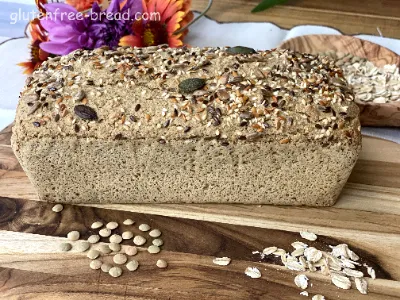Additional info
Oat flour comes in several types, each with its own characteristics and uses. Here are the main types of oat flour and their differences:
Regular Oat Flour:
- This is the most common type of oat flour, made from grinding whole oats (both rolled oats and steel-cut oats).
- It has a moderate texture and is suitable for a wide range of baking applications, such as bread, muffins, pancakes, and cookies.
- Regular oat flour retains more of the oat's natural fiber and nutrients compared to more refined flours.
Fine Oat Flour:
- Fine oat flour is ground more finely than regular oat flour.
- It has a smoother texture and is often used in recipes where a finer texture is desired, such as cakes, pastries, and delicate baked goods.
- Fine oat flour can be more challenging to find commercially but can be achieved by grinding regular oat flour further in a blender or food processor.
Gluten-Free Oat Flour:
- Gluten-free oat flour is made from oats that are certified gluten-free, ensuring they are processed in facilities that avoid cross-contamination with gluten-containing grains.
- This type of oat flour is suitable for individuals with celiac disease or gluten sensitivity.
- It can be used interchangeably with regular oat flour in recipes.
Toasted Oat Flour:
- Toasted oat flour is made by toasting oats before grinding them into flour.
- Toasting enhances the nutty flavor of the oats and can add depth to baked goods like bread, cookies, and granola.
- It has a slightly darker color and a richer flavor compared to untoasted oat flour.
Instant Oat Flour:
- Instant oat flour is finely ground oats that have been partially cooked and dried.
- It dissolves quickly in liquid, making it suitable for thickening sauces, gravies, and soups, as well as for use in smoothies and baking.
- Instant oat flour is also used in instant oatmeal packets and other convenience foods.
When choosing oat flour for a recipe, consider the texture and flavor you want to achieve. Regular oat flour is versatile and widely available, while finer or specialty oat flours may be required for specific baking needs or dietary preferences.
Oat flour is a popular ingredient in gluten-free bread recipes for several reasons. Here’s why oat flour is commonly used and how it contributes to gluten-free bread:
Texture and Structure: Oat flour adds a desirable texture and structure to gluten-free bread. It helps mimic the elasticity and binding properties that gluten provides in traditional wheat bread.
Flavor: Oat flour has a mild, slightly sweet flavor that complements many bread recipes without overwhelming other ingredients.
Nutritional Benefits: Oat flour is nutritious, providing dietary fiber, protein, vitamins (like B vitamins), and minerals (such as iron, magnesium, and zinc). This adds nutritional value to gluten-free bread, which can sometimes lack in fiber and nutrients compared to wheat-based breads.
Moisture Retention: Oat flour helps retain moisture in gluten-free bread, preventing it from becoming dry and crumbly.
Versatility: Oat flour can be used alone or in combination with other gluten-free flours (like rice flour, almond flour, or tapioca flour) to create a balanced texture and flavor profile in bread recipes.
When using oat flour in gluten-free bread recipes, consider the following tips:
Certified Gluten-Free: Ensure your oat flour is certified gluten-free to avoid cross-contamination with gluten-containing grains during processing.
Mixing with Other Flours: Experiment with different ratios of oat flour to other gluten-free flours to achieve the desired texture and rise in your bread. Combining oat flour with starchier flours (like tapioca or potato starch) can help improve the structure.
Hydration: Oat flour absorbs more moisture compared to some other gluten-free flours. Adjust the liquid content in your recipe to achieve the right dough consistency.
Binding Agents: Since gluten-free bread lacks the natural binding properties of gluten, consider adding additional binding agents such as xanthan gum or guar gum to help hold the bread together.
Baking Time and Temperature: Gluten-free bread may require slightly longer baking times at lower temperatures to ensure it cooks through without burning or drying out.
By carefully selecting and using oat flour in your gluten-free bread recipes, you can create delicious and nutritious bread that meets dietary restrictions without compromising on taste or texture.
Baking oat flour bread, especially in gluten-free recipes that often incorporate psyllium husk, comes with several pros and cons. Here’s a breakdown:
Pros:
Health Benefits:
- Nutrient-Rich: Oat flour is rich in fiber, vitamins (like B vitamins), and minerals (such as iron and magnesium), providing nutritional benefits compared to refined flours.
- Gluten-Free: Suitable for individuals with gluten intolerance or celiac disease.
Texture and Flavor:
- Oat flour contributes to a moist, tender crumb and adds a mild, slightly sweet flavor to bread.
Binding Properties:
- Psyllium husk, commonly used in gluten-free recipes with oat flour, acts as a binder and helps improve the structure of the bread.
Versatility:
- Oat flour can be used in a variety of recipes beyond bread, including pancakes, muffins, and cookies, offering versatility in gluten-free baking.
Dietary Fiber:
- Oat flour provides soluble fiber, which can help promote digestive health and contribute to a feeling of fullness.
Cons:
Texture Challenges:
- Gluten-free bread made with oat flour and psyllium husk can sometimes have a denser texture compared to wheat-based bread. Achieving a light and airy texture can require experimentation with ingredients and techniques.
Hydration Management:
- Oat flour absorbs moisture differently than wheat flour. Finding the right balance of liquid in gluten-free baking is crucial to prevent bread from being too dry or too wet.
Potential Color Changes:
- Psyllium husk, if used in large quantities or baked for extended periods, can darken the color of bread. This can affect the appearance, though it doesn't typically impact taste or nutrition.
Adjustment Period:
- Baking gluten-free bread, especially for those new to gluten-free baking, may require an adjustment period to understand how different flours and ingredients behave together.
Availability and Cost:
- Specialty flours like oat flour and psyllium husk can be more expensive and less readily available compared to traditional wheat flour, depending on your location and market.
Overall, baking oat flour bread can be a rewarding experience, offering a nutritious alternative for those with dietary restrictions. While it may come with some challenges, understanding these and experimenting with recipes can help you achieve delicious results that meet your dietary needs and preferences.











